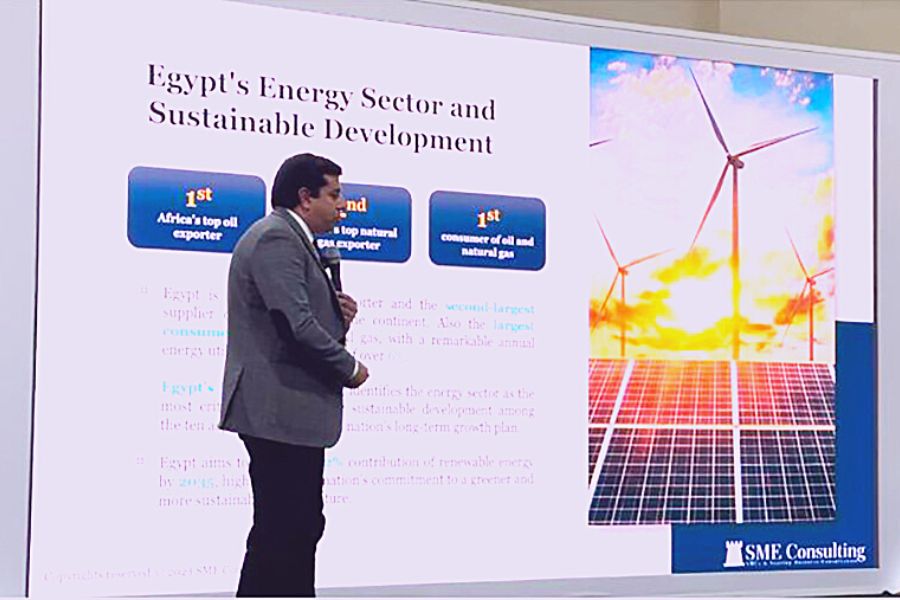Egypt Energy leaders highlight international power connections

Two experts describe Egypt as regional power hub with connections to three continents, exporting surplus power with renewables rising to 62.6 GW by 2035; listing connectivity projects powered by renewables
Egyptian officials say Egypt has taken significant steps to become a regional power trading hub, noting that the country has already made progress in connecting its electricity grid with neighboring countries such as Sudan and Libya and has plans to expand its interconnection infrastructure to other Mediterranean, North African and Middle Eastern countries.
Day 2 of the Egypt Energy Leadership Conference, in Cairo last week, saw Egyptian officials and energy experts emphasizing the feasibility of electrical interconnection projects to stimulate the expansion of renewable energy sources and support the reliability of regional grid networks.
Egyptian officials shed light on Egyptian electrical interconnection projects and the future of renewable energy projects in Egypt, including solar, wind, and green hydrogen.
Stable electricity grid
In her presentation titled “Electricity markets: Opportunities and challenges”, Eng. Naglaa Khattab, General Manager for Studies of Interconnection Projects, Egyptian Electricity Transmission Company (EETC) highlighted Egyptian electrical interconnection projects.
She confirmed that Egypt has all the advantages that qualify it to achieve success, including security and political stability to attract investment.
“The distinctive geographical location between 3 continents (Africa - Asia - Europe), and the diversity of sources of electricity production from natural gas, solar energy, wind and hydropower,” are important, she said.
She explained that Egypt has a strong and stable electricity network, which is considered one of the largest networks in the region and is characterized by a surplus of electricity for export.
“Electricity generation capacities amounting to 28,229 MW, were added from 2014 until 2022, bringing the total capacity of the Egyptian network to about 60 GW.”
Egypt has adopted a strategy to increase the participation of renewable energy in the total energy mix to 42% by 2030.
Regional connectivity: Africa, Europe and Asia
Khattab explained that Egypt has a number of electrical interconnection projects in Africa, and studies are currently being conducted to examine the possibility of increasing the capacity of the interconnection line with Libya from 150 MW to 2000 MW.
She pointed out that the capacity was increased last January from 100 to 150 MW based on a request of Libya.
“The first phase of the electrical connection with Sudan ended in April 2020 with a capacity of 80 MW, and the line will be operated at its full capacity of 300 MW by the end of this year.”
Regarding interconnection projects with Asia, she explained that a study is currently underway to increase the capacity of the interconnection line between Egypt and Jordan from 550 to 2,000 MW at a voltage of 400 kilovolts, allowing electricity to be exported to Iraq, Syria, and Lebanon via Jordan.
“The timetable for the electrical interconnection project between Egypt and Saudi Arabia stipulates the start of operation of the first phase in October 2025 with a capacity of 1,500 MW.”
She also highlighted interconnection projects with Europe, noting the signing of an agreement of intent in 2022 between the Egyptian Electricity Transmission Company and the Emirati K&K Group to begin discussions on a project to export clean energy from Egypt.
“In May 2023, a MOU was signed between the Egyptian Electricity Transmission Company and Scatec to begin studies of a project to export renewable energy from Egypt to Europe via Italy.”
She explained that the bilateral MOU for the electrical interconnection project between Egypt and Greece was signed in 2021 to exchange capacity amounting to approximately 3,000 MW.
Goals and initiatives
Dr. Mohamed El Bana, Logistics and Supply Chain Head & Partner, SME Consulting, highlighted renewable energy projects in Egypt. His presentation was titled “Prospects for Sustainable Energy Infrastructure Development and Role of Cross-Border Energy Trade.”
“Egypt is Africa's top oil exporter and the second-largest supplier of natural gas on the continent.
“Also the largest consumer of oil and natural gas, with a remarkable annual energy utilization growth rate of over 6%,” he said.
He explained that renewable energy capacity installed in Egypt reached approximately 19.2 GW in 2021, and the government aims to achieve 50.5 GW of renewable energy generation by 2029/2030 and 62.6 GW by 2034/2035.
“Achieving these targets requires significant promotion and investment in renewable energy resources.”
“The transition to renewable energy sources will enhance energy sustainability, reduce reliance on fossil fuels, and contribute to global efforts in combating climate change,” he added.
Renewable power potential
El Bana highlighted that the Nile River is Egypt's most crucial hydroelectric resource, contributing to a combined capacity of 2,800 MW and an annual electric generation capacity of 13,545 GWh.
“Since 2016, the development of hydropower stations has ceased as the government shifted its focus to solar, wind, and conventional power stations utilizing gas turbines,” he said.
He pointed out that Egypt possesses a significant solar energy potential of 74 billion MWh per year, confirming that Solar energy projects in Egypt have been recognized as economically viable.
“The predicted figure is significantly more than Egypt’s current electricity production.”
El Bana highlighted that Egypt is endowed with a plethora of inexhaustible wind energy supply in the Sinai Peninsula and areas surrounding the Gulf of Suez.
He noted that Egypt has successfully developed wind energy projects like Zafarana Wind Farm, Jabal Al-Zayt wind farms 1 & 2, and Gulf of Suez wind farm.
Green H2
El Bana pointed out that Egypt is a potential global center for green hydrogen export. Its strategic location at the Red Sea and the Mediterranean Sea enables easy access to neighboring countries and Europe for the export of green hydrogen in gaseous form or as a liquid, utilizing tankers as a liquid, either as hydrogen or liquid ammonia.
“Egypt has taken proactive steps to develop its green hydrogen industry through the establishment of the first electrolyzer plant at Ain Sokhna and the formation of the National Green Hydrogen Council,” he added.
Egypt Energy Leadership Conference 2023, at Egypt International Exhibition Centre (EIEC) in Cairo last week, had more than 55 experts and 150 companies operating in various energy fields.
Energy & Utilities reported that the Egypt Energy Leadership Conference confirms the country's rapid energy transition. E&U reported this year on an agreement to jointly develop renewable energy projects for an Egypt-Greece green energy interconnector.
Energy & Utilities - Middle East and Africa Market Outlook Report 2024.
This must-have report for industry players offers a thorough understanding of the latest developments, challenges, and opportunities in the region, supported by data, analysis, and expert insights.


.png)
.png)

